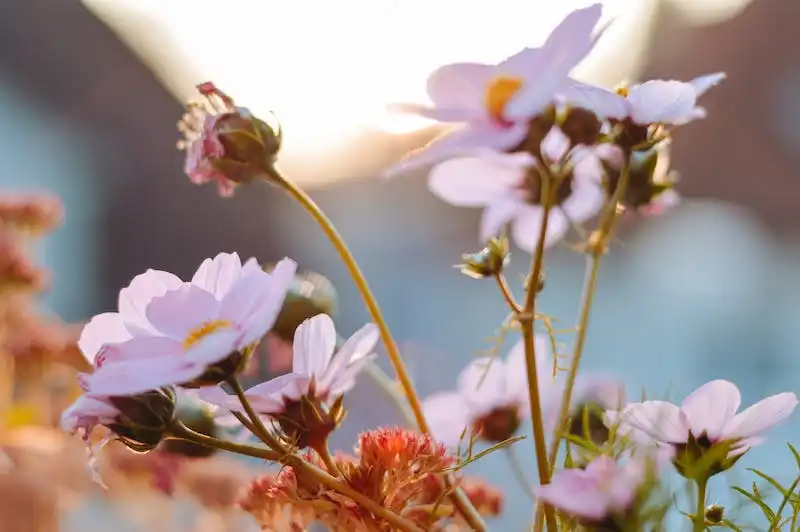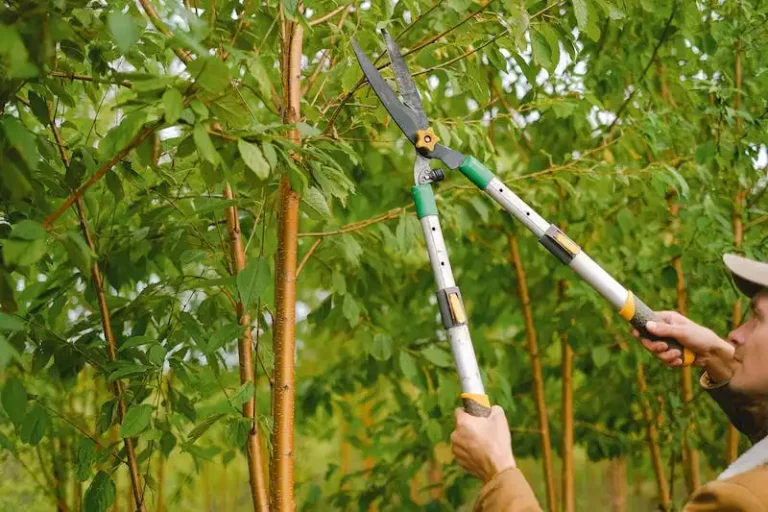The burning bush, scientifically called Euonymus alatus, is a stunning deciduous shrub native to East Asia. With its fiery appearance and warm tones, it has become a favorite among gardeners around the world. In the spring, the burning bush blooms with small, yellow-green flowers. Later in the year, it develops heavy clusters of brilliant red fruits, which remain on the bush throughout the winter.
Once established, the burning bush can be quite low-maintenance. It is resistant to most pests and diseases, making it an ideal choice for beginner gardeners. However, there are a few issues that may need attention. One common problem is powdery mildew, a fungal disease that can affect the leaves and stems. If powdered mildew appears, it can be treated with a fungicidal application.
When it comes to planting, the burning bush prefers a spot with full sunlight, although it can tolerate light shade. It is important to choose a well-draining location, as the bush does not do well in wet or water-logged soil. Additionally, the burning bush prefers alkaline soil, so it may be necessary to amend the soil with limestone or other alkaline sources.
Pruning the burning bush is key to maintaining its shape and preventing it from becoming too invasive. It is best to prune the bush in late winter or early spring while it is still dormant. Remove any dead or damaged branches, as well as any crossing or rubbing branches. To encourage growth and vigor, it is recommended to prune the bush back to its main framework.
If you want to propagate the burning bush, there are a few methods you can try. One option is to take cuttings in early summer and root them in a light soil mixture. Another option is to collect the winged fruits in the fall and sow them directly into the garden. The seeds will then self-seed and grow into new plants.
In conclusion, the burning bush is a beautiful and eye-catching specimen that can bring color to any garden. By following the guidelines for planting, watering, fertilizing, and pruning, you can ensure that your burning bush remains healthy and vibrant for years to come. So go ahead and add this stunning shrub to your garden and enjoy the brilliant display it offers!
Burning Bush Pruning Care and Planting Tips
Pruning is an important part of caring for a burning bush plant. Regular pruning helps maintain the plant’s size and shape, controls its growth, and promotes overall health. It is best to prune the burning bush plant in the early spring or late winter before it starts actively growing.
When pruning, remove any dead, damaged, or diseased branches. This will create a cleaner and healthier appearance for the plant. You can also prune to create a denser and more compact bush, or to remove any crossing or rubbing branches.
Before repotting, it is important to consider the requirements of the burning bush plant. They prefer well-draining soil, so choose a pot with drainage holes. Repotting can be done every few years, as the plant quickly grows in size. Make sure to provide plenty of sunlight for the plant to thrive.
When planting a burning bush, it is beneficial to prepare the area beforehand. Choose a sunny spot in your garden and ensure there is enough space for the bush to grow. Remove any weeds or grass and loosen the soil to promote better root growth. Consider spacing requirements, as this plant can grow between 6 and 10 feet. Adding mulch around the base of the plant will help retain moisture and suppress weed growth.
While the burning bush plant is generally low-maintenance, it is still important to pay attention to its needs. Regular watering is necessary, especially during dry periods. These plants are more drought-tolerant once established, but will benefit from a steady supply of moisture. However, be cautious not to overwater, as it can lead to root rot.
Burning bush plants can attract pests and be susceptible to fungal diseases. Check the plant regularly for any signs of pests such as aphids or spider mites. If detected, take immediate action to prevent further damage. Fungal diseases can be prevented by ensuring proper air circulation and avoiding overwatering.
To achieve a healthy and compact burning bush, pruning is suggested to promote a more manageable size. Smaller varieties called dwarf burning bushes are available, which require less pruning and fit well in smaller garden spaces.
In conclusion, taking care of a burning bush plant involves regular pruning, repotting every few years, and providing the right conditions for growth. With proper attention and care, the burning bush can bring both beauty and functionality to your landscaping.
Sunlight Requirements
The burning bush plant has incredible sunlight requirements. It needs at least four hours of direct sunlight per day to thrive. However, it can tolerate partial shade and still grow, although it may not reach its full potential. With its hardiness in USDA hardiness zones three to eight, the burning bush can grow in a variety of lighting conditions.
When it comes to rooting, burning bushes always prefer sunny spots. Smaller varieties can also tolerate some shade, but full sun is generally best for optimal growth. The burning bush’s leaves are at risk of developing powdery mildew if they receive too much shade, so it’s important to provide as much sunlight as possible.
One of the best ways to ensure a healthy appearance and low-maintenance care for burning bushes is to plant them in a location that gets full sun throughout the day. This helps prevent common pests and diseases from taking hold, as they thrive in shady, humid conditions. It also helps the plant grow and spread quickly.
When it comes to applying fertilizer, burning bushes have relatively low nutrient needs. They typically benefit from an application of balanced fertilizer in the spring, just before new growth begins. However, be cautious with fertilizer around established plants, as they can easily become over-fertilized, which can lead to harmful problems.
Watering is crucial for burning bushes, especially during the first few years after planting and during dry spells. While the plant is relatively tolerant of drought, it still needs consistent moisture. Aim to keep the soil evenly moist, but not waterlogged. The frequency of watering will depend on the humidity levels and drainage of the soil. Avoid overwatering, as this can lead to root rot and other issues.
If you’re growing burning bushes in a location where the winters are particularly harsh, providing some protection can help ensure their survival. Creating a windbreak using mulch or planting them close to a building or other structure can help provide some shelter.
Pruning is an important part of caring for burning bushes. Regular pruning helps maintain the desired shape and size of the plant, prevents the growth of suckers, and keeps the plant healthy. Pruning should be done in late winter or early spring before the new growth begins. Remove any broken or damaged branches, as well as any that are crowding the center of the plant.
In conclusion, burning bushes require a good amount of sunlight to thrive. They can tolerate partial shade, but full sun is generally best. Providing adequate sunlight, proper watering, and occasional pruning will help ensure that your burning bush plant remains healthy and beautiful for years to come.
Soil Requirements
The burning bush plant, also known as Euonymus alatus, has specific soil requirements in order to thrive. Here are the important aspects to consider when it comes to the soil for your burning bush:
1. Drainage: Good drainage is crucial for the health of the plant. Ensure that the soil does not become waterlogged, as this can lead to root rot and other problems. If the soil in your area is heavy and compacted, it’s a good idea to amend it with organic matter to improve drainage.
2. Moisture: While the burning bush plant prefers well-draining soil, it also needs consistent moisture to grow and thrive. Keep the soil evenly moist, but avoid overwatering, as this can cause root diseases. Check the moisture level regularly and adjust your watering schedule accordingly.
3. Light: The burning bush plant thrives in full sun to part shade conditions. It can tolerate some shade, especially in hot climates, but too much shade can result in a less vibrant foliage color. Aim for at least 6 hours of direct sunlight per day for optimal growth and appearance.
4. Fertilizing: Burning bushes generally do not require much fertilizing. However, if you notice slow growth or yellowing leaves, you can apply a balanced fertilizer in early spring. Follow the instructions on the fertilizer packaging for the correct application method and dosage.
5. Planting: When planting a burning bush, choose a location that meets its light and moisture requirements. Ensure that there is enough space for the bush to spread, as it can grow quite large if left untrimmed. A spacing of 5 to 8 feet apart is a good rule of thumb. Proper spacing will allow for good air circulation and prevent diseases.
6. Mulch: Applying a layer of mulch around the base of the burning bush plant can help retain moisture, suppress weed growth, and regulate soil temperature. Use organic mulch such as wood chips or shredded bark, and apply it in a layer about 2 to 3 inches thick. Avoid piling the mulch against the trunk of the plant, as this can lead to rot.
By considering these soil requirements, you can ensure that your burning bush plant thrives and adds a burst of vibrant color to your garden. Taking the time to create a suitable environment will reward you with a beautiful and healthy plant for many years to come.
Watering Requirements
The burning bush plant requires regular waterings to maintain its health and vigor. Proper watering techniques are essential in order to keep the plant thriving.
When it comes to watering your burning bush, it’s best to water deeply and infrequently. You want to make sure that the water reaches the root zone, which is approximately two to four inches below the soil surface. Watering deeply encourages the roots to grow deeper, resulting in a stronger and more resilient plant.
It’s important to note that over-watering can be detrimental to the burning bush. Waterlogged soil can lead to root rot, which can ultimately kill the plant. To prevent over-watering, ensure that the soil has proper drainage and does not stay constantly wet.
The type of soil in which the burning bush is planted also plays a significant role in its watering requirements. Well-drained soil is crucial for the plant’s overall health and growth. Ideally, the soil should be loose and loamy, allowing water to drain freely.
Gardeners should also be cautious about watering during periods of high humidity. Excessive moisture in the air can contribute to the development of fungal diseases, such as powdery mildew. If you notice a powdery white substance on the leaves, it is likely powdery mildew and should be addressed immediately.
Before watering, always check the moisture level of the soil. A quick glance at the soil’s surface can provide some indication of its dryness. If the top inch or two of the soil feels dry to the touch, it’s time to water.
When watering the burning bush, it’s important to water at the base of the plant, near the main stem. This allows the water to be absorbed directly by the roots and reduces the risk of moisture-related diseases.
An easy-to-grow plant, the burning bush does not require any specific type of water. However, some gardeners have reported that using rainwater has benefited their plants, as tap water may contain high levels of chlorine and other chemicals.
During periods of prolonged drought, it may be necessary to water the burning bush more frequently. Keep an eye on the plant’s overall appearance and monitor its growth. If you notice wilting leaves or a lack of vigor, it’s a sign that the plant may be experiencing drought stress and requires additional watering.
In conclusion, proper watering is crucial to the health and growth of a burning bush plant. By following these watering guidelines and being mindful of the plant’s needs, you can ensure that your burning bush remains vibrant and beautiful throughout the growing season.




